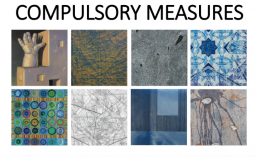Commitment and Immersion, Contemporary Mark-Making Essay
Commitment and Immersion, Contemporary Mark-Making
By Amy G. Moorefield, Director of the Phillips Museum of Art at
Franklin & Marshall College
What is a compulsion? Denoting a self-imposed act by a need driven from within, it compels a person to behave in a specific, almost formulaic manner using complex and repetitive systems or codices. We all perform in compulsive ways to a certain extent. Likewise, the exhibiting artists of Compulsory Measures — Jorge Benitez, Kristy Deetz, Al Denyer, Joan Elliott, Reni Gower, Steven Pearson, Jennifer Printz, and Tanja Softic´— all make work in ongoing methods that fall under the rubric of compulsive acts. Their art-making pursuits use very different processes yet all have a core methodology unifying their work through their studio methods. These employ a ritualistic potency that oftentimes becomes the final outcome of their specific approach.
So why gang these artists under the category of compulsive making? Should their art making efforts really be labeled compulsive? Contemporary mixed media artist Marilyn Minter counters that all artists have compulsive natures, and states, “we are all OCD here (Artinfo and ARTINFO, 2018).” Instead she implores that the term “compulsion” be erased as a current identifier of the art world today. Perhaps a better unifying theme around which to coalesce these exhibiting artists would be their dedicated commitment to their respective studio practice that involves intensive engagement through laborious and repetitive processes. Take for example the work of modern Canadian-American artist Agnes Martin (1912-2004), known for her habitual patterning of circles and grids that she painted again and again. Both forms identify her as the author by her mark-making, and through her recognizable process, each work became a meditation on abstract form. Or take contemporary Japanese artist Yayoi Kusama, known for her sculptures, paintings, and installations created with polka dots. She coats her surfaces with thousands of dots often paired with mirrors, employing them as a signature motif to explore notions of infinity. These are but a few examples of artists who have used intensive studio practices with repetitive patterning to define their work.
Likewise, as displayed in the exhibition, Compulsory Measures, the eight artists’ work gives evidence to their own physical immersion in the studio, with each portraying resolute fascination with their given specific mode of expression. Both Jorge Benitez and Kristy Deetz make work using unorthodox processes regarding their subject matter. Jorge Benitez’s small still life paintings and drawings of architectural elements are created through intensive concentrated looking. Instead of employing photography or drawings as sketches for the finished painting, Benitez creates work fully formed without those classically used preliminaries. In this way, Benitez claims, “(that) mildly masochistic process is central to my compulsory measures. It forms the core of my being.” Kristy Deetz traces the physical history of a human’s imprint on cotton – its folds, creases, and wrinkles¬ – into paint. Using a cotton scarf as a studio object, Deetz creates marks not to just duplicate the topographic history of the scarf but to elicit the memory of the hand’s work manipulating it.
Other artists such as Al Denyer, Joan Elliott and Reni Gower use specific motifs as core talismans. Al Denyer’s ink on paper works reference microscopic views of human skin, a leaf or a strange alien planet. Methodically rendered with rich black pigment, their delicate ambiguity compels close looking. Descended from a long lineage of fiber arts workers, Joan Elliott’s laborious marks reference that lineage yet pay homage to the rhythmic patterning found in sacred geometry. Through repetitively applying and then sanding layers of oil and graphite, she gives her diaphanous paintings the appearance of a palimpsest, appearing both solid and ephemeral at the same time. Reni Gower’s focused and tactile sensibility is paired with rhythmic patterning. Using color to unify her composition, Gower employs the power of the repeated circle, “as a multicultural motif, as a metaphor for binary code, and as a universal symbol of continuity and perfection.”
And finally, Steven Pearson, Jennifer Printz and Tanja Softic´ surf their personal narratives to develop work that honors memory yet provides access for viewer introspection. Steven Pearson employs his past combined with contemporary news stories to methodically create layered memory maps on frosted Dura-Lar®. Developing alternative and blurred “timelines, Pearson states, “The final renditions of fragmented and layered histories enact the ways that we collectively experience multiple temporalities in the present.” Mixed media artist Jennifer Printz’s complex skyscapes seek understanding of the larger universe. Using photographs taken of the sky in her hometown, Printz carefully creates a new horizon line by carefully and “lovingly” overlaying delicate graphite marks until in some instances they obliterate the original photograph. A native of Sarajevo, Tanja Softic´ carefully combines images of the natural and man-made world through the lens of – in her words – “cultural belonging, hybridity and memory.” Using a complex matrix of printmaking, drawing and photography in her process, she references the tactile nature of the paper while forming “maps of change.”
Capitalizing on the inherent formal relationships expressed in their work and the stories that each tell, the artists of Compulsory Measures intensive fealty to their studio practice confounds our expectations. Call their artistic acts compulsive, ritualistic or systematic — their outcomes inspire awe.
Works Citied:
Artinfo, B. and ARTINFO, B. (2018). Compulsive Overuse: Why the Art World Needs to Drop the Term OCD; | Artinfo. [online] Artinfo. Available at: https://www.blouinartinfo.com/news/story/1098164/compulsive-overuse-why-the-art-world-needs-to-drop-the-term [Accessed 23 Dec. 2018].
